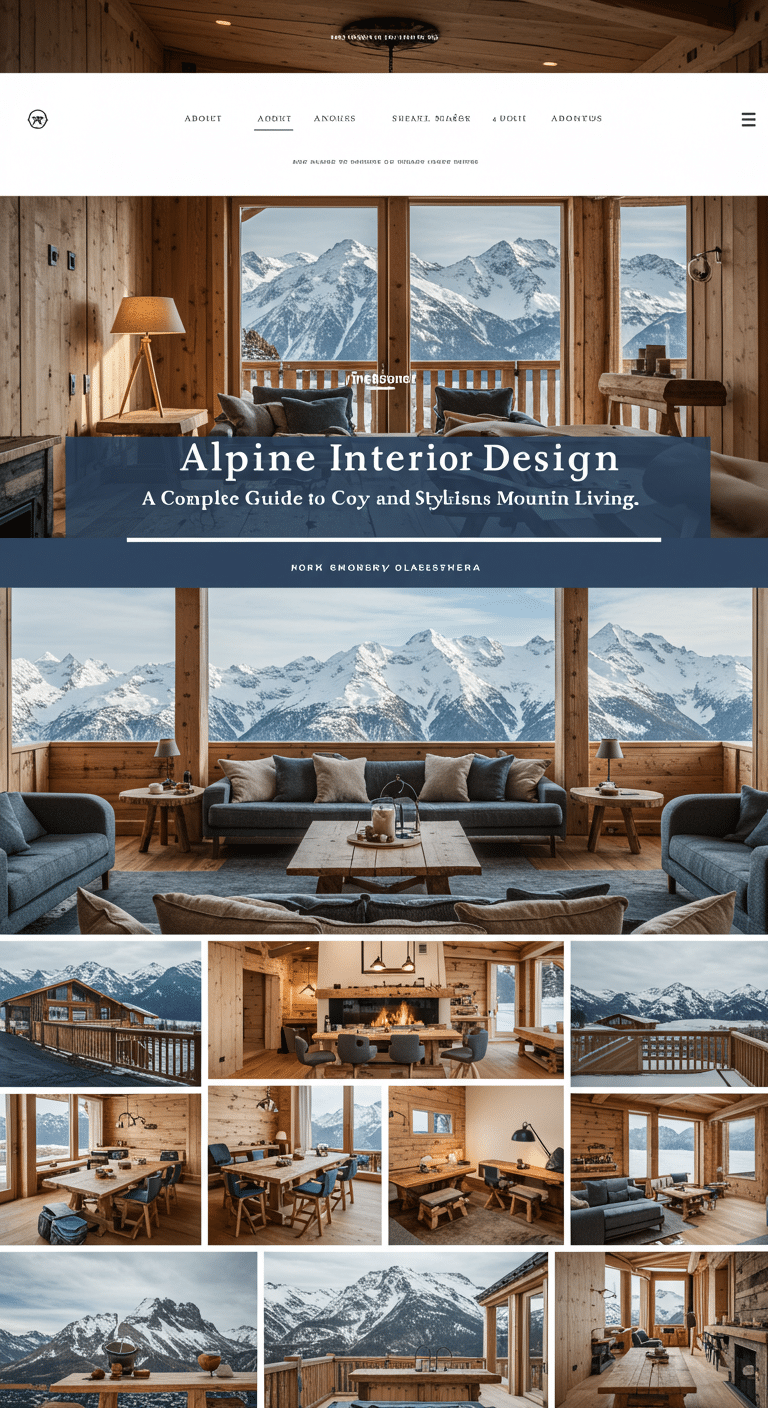Alpine interior design is inspired by the breathtaking beauty of the mountains, combining rustic charm with modern comfort. This style creates a space that feels warm, inviting, and deeply connected to nature. Natural elements like wood, stone, and wool dominate the design, offering both texture and coziness. Large windows invite panoramic views, while soft lighting sets a calming mood. Whether you live in a mountain cabin or a city apartment, alpine design adapts beautifully. It’s all about creating a space that feels like a serene escape from the busy world.
Origins of Alpine Interior Design
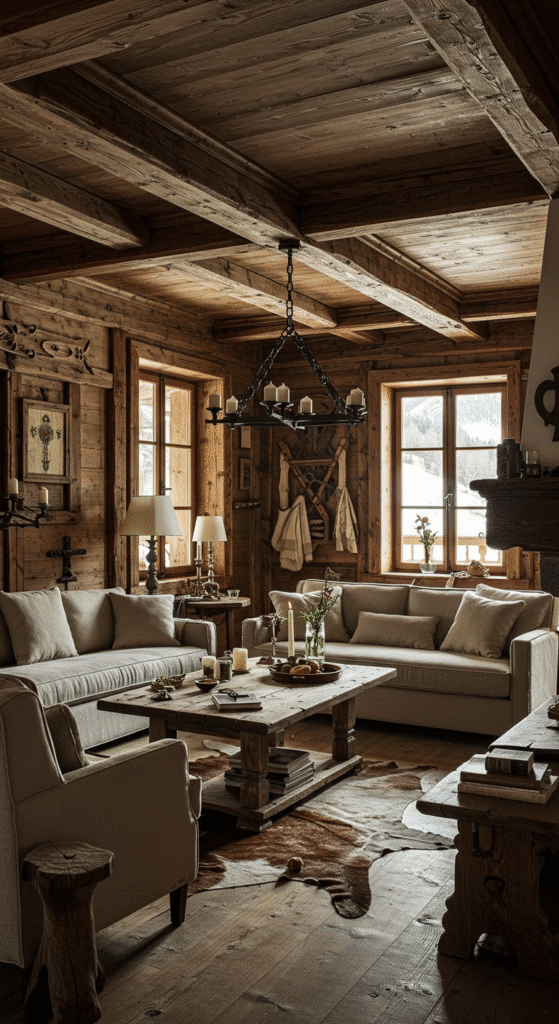
The roots of alpine design come from traditional chalets in the Alps, where families sought warmth and function during cold winters. These mountain homes relied heavily on local materials like timber, stone, and wool for insulation and comfort. Over time, these functional interiors evolved into an aesthetic of coziness and natural beauty. Today, alpine style has gone global, admired for its warm atmosphere and timeless appeal. By blending history with modern sensibilities, it brings old-world charm into contemporary homes. This origin story explains why authenticity is key to the alpine aesthetic.
Key Characteristics of Alpine Design
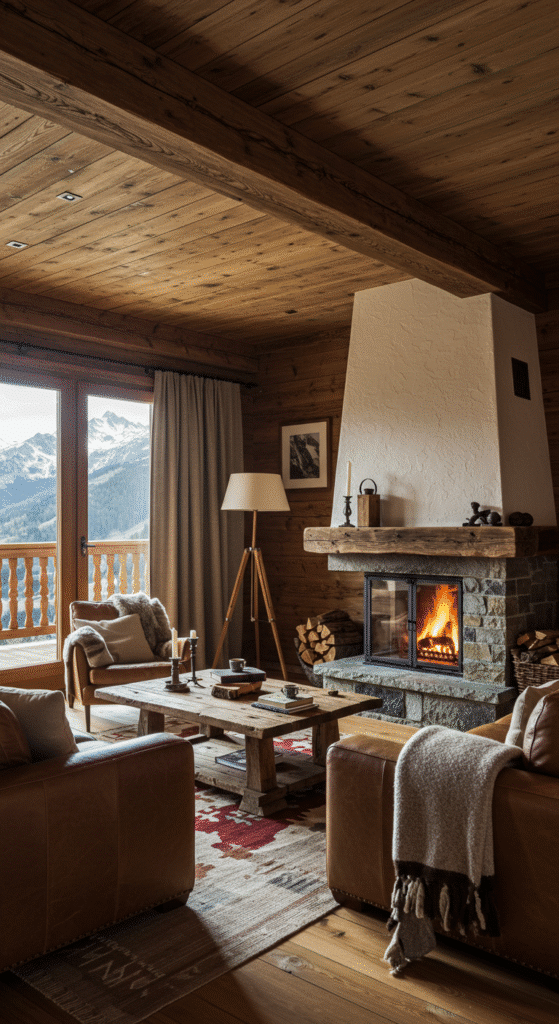
Alpine interiors are defined by their cozy, rustic yet refined elements that bring mountain living indoors. Wood is often the star material, from exposed beams to handcrafted furniture. Stone fireplaces add both visual and physical warmth, becoming focal points of living spaces. Fabrics are soft and layered, often featuring wool, linen, and faux fur. Neutral tones dominate, with earthy shades that echo natural surroundings. The style balances practicality with beauty, creating spaces that feel both stylish and livable. These elements together define the unmistakable alpine look.
Natural Materials in Alpine Interiors
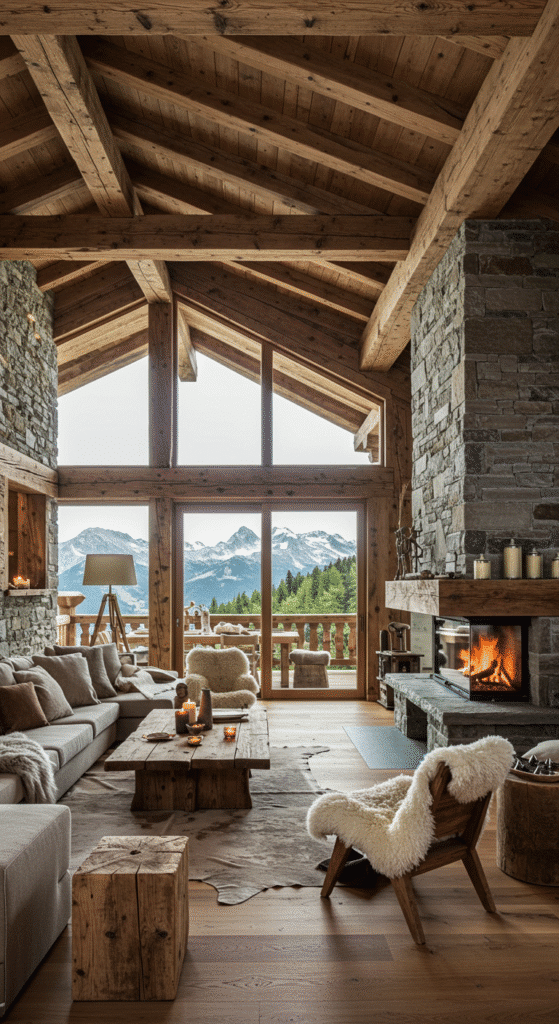
Natural materials are the foundation of alpine interior design, making spaces feel authentic and organic. Wood is widely used in flooring, walls, and furniture, offering warmth and texture. Stone adds rugged beauty and durability, often seen in fireplaces or accent walls. Leather, wool, and linen create tactile comfort through upholstery and textiles. These materials not only look good but also age beautifully, gaining character over time. Using locally sourced materials enhances sustainability while honoring traditional alpine practices. This connection to nature is what makes alpine interiors timeless and grounding.
The Importance of Wood in Alpine Design
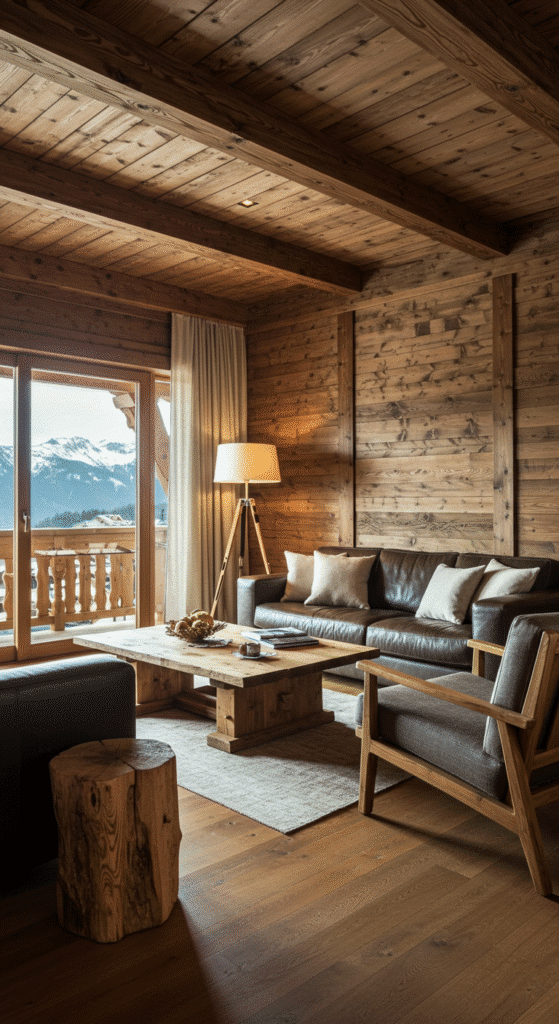
Wood plays a central role in alpine interiors, offering warmth and natural beauty. From exposed ceiling beams to rustic furniture, it gives every space a cozy, welcoming feel. Different types of wood—pine, oak, and cedar—each bring their own character and color. Light stains highlight grain patterns, while darker finishes add depth and drama. Wooden floors paired with rugs enhance comfort and warmth underfoot. Incorporating wood is not just aesthetic—it symbolizes tradition and a link to the natural alpine environment. This material ensures interiors feel rooted in nature.
Stone Elements in Mountain Interiors
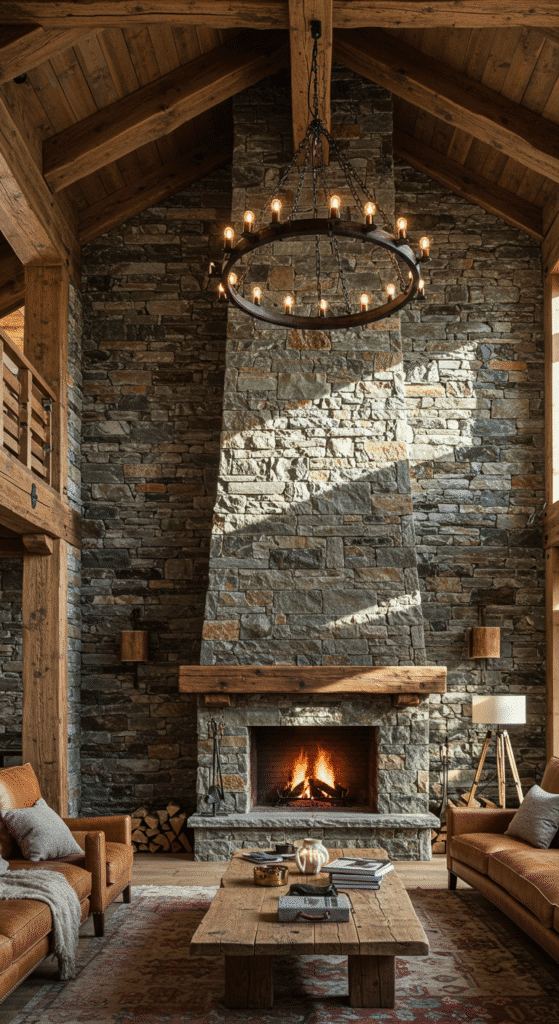
Stone adds rugged charm and a grounding element to alpine interiors. It is often used for fireplaces, accent walls, or flooring to bring a raw, natural feel indoors. Large stone fireplaces create a dramatic centerpiece in living rooms, perfect for gathering around in winter. Slate or granite tiles add durability and rustic beauty to kitchens and bathrooms. When combined with wood, stone balances warmth with strength. Its organic texture enhances the tactile richness of alpine spaces. This timeless element ensures alpine interiors maintain an authentic mountain lodge feel.
Cozy Textiles and Soft Layers
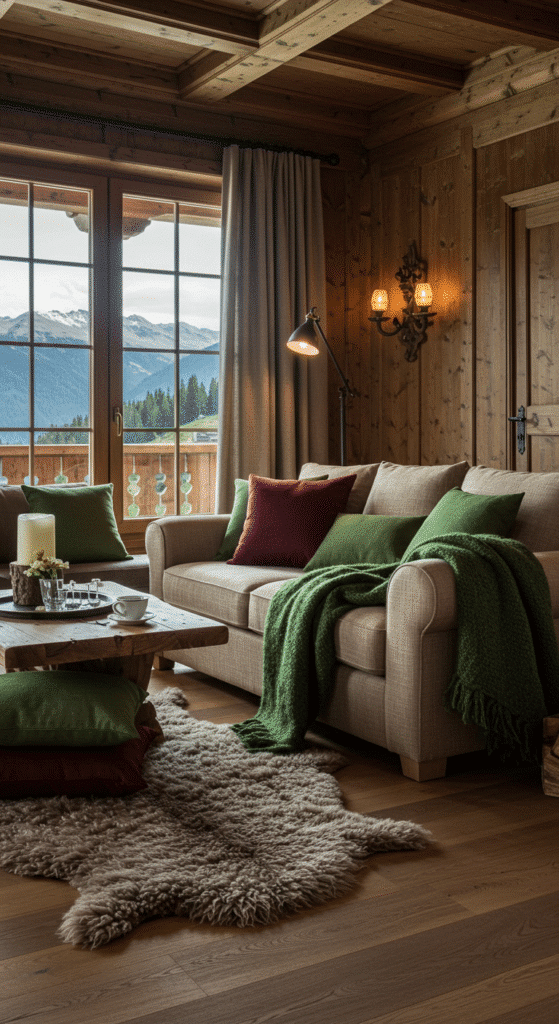
Layering textiles is essential in alpine interior design to create warmth and coziness. Wool blankets, faux fur throws, and linen cushions add texture and comfort. Area rugs made of natural fibers soften wooden floors and enhance the feeling of homeliness. Curtains and drapes in thick fabrics not only provide insulation but also elevate the aesthetic. Mixing different textures ensures visual interest without overwhelming the space. These textiles encourage relaxation, making every corner inviting. By focusing on tactile comfort, alpine interiors achieve the signature “warm embrace” atmosphere.
Color Palettes in Alpine Interiors
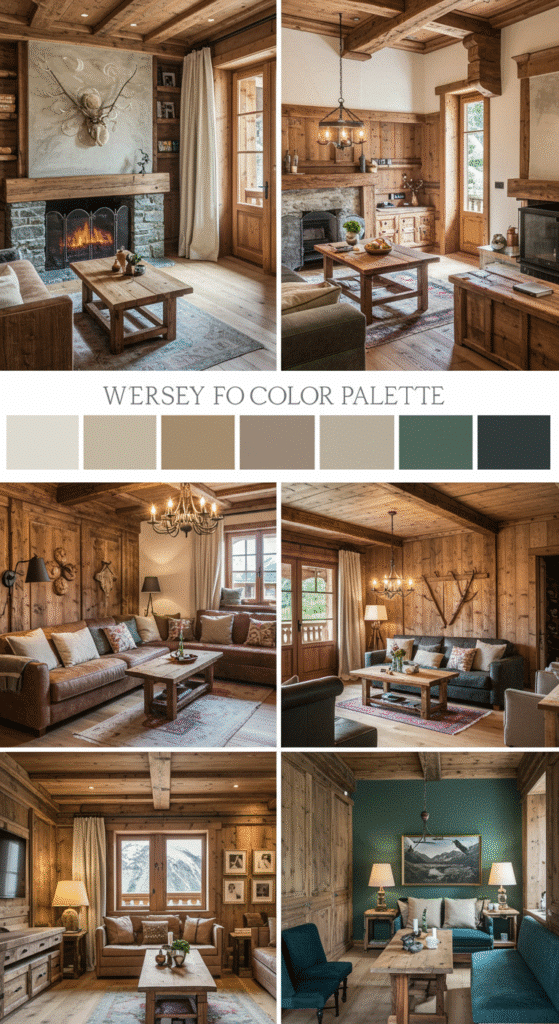
Alpine color palettes draw inspiration from natural surroundings—earth, sky, and snow. Neutral tones like beige, taupe, and soft gray dominate, creating a calm backdrop. Accents of deep green, navy, or burgundy reflect the alpine landscape. White is used to mimic snowy peaks, bringing brightness into interiors. Warm wood tones add depth and keep spaces from feeling cold. Layering these shades creates harmony, balance, and a timeless aesthetic. This color scheme ensures alpine interiors feel both soothing and deeply connected to nature.
Lighting for Alpine Atmosphere
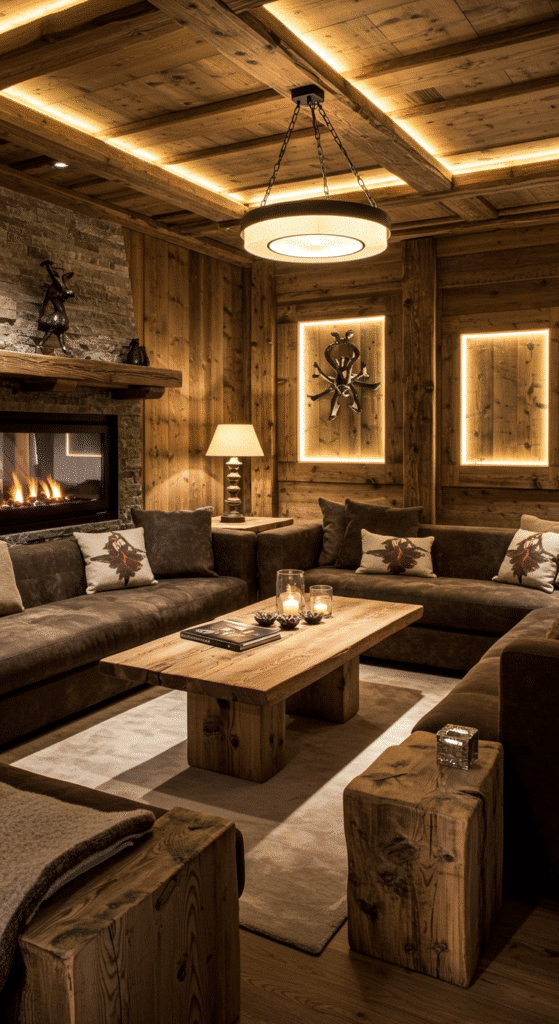
Lighting is essential to capture the cozy alpine ambiance. Warm-toned lights mimic the golden glow of firelight, perfect for winter evenings. Chandeliers made of wrought iron or wood add rustic elegance. Floor and table lamps with linen shades create soft pools of light for relaxation. Candles and lanterns introduce a romantic, intimate glow. Natural light is equally important, with large windows framing scenic views. This blend of artificial and natural lighting ensures alpine interiors feel warm, inviting, and perfectly balanced.
Open Spaces with Mountain Views
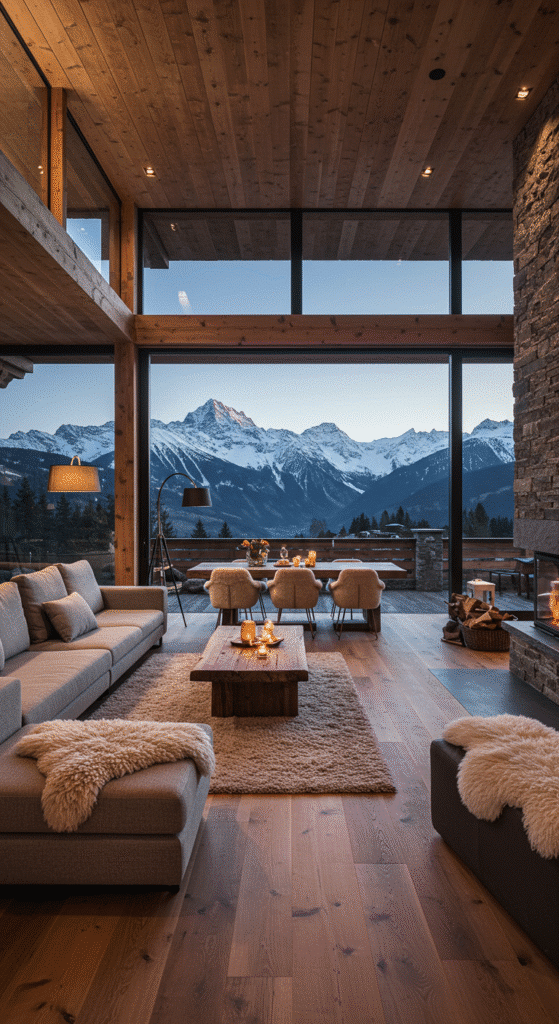
Alpine design emphasizes openness, with large windows and open floor plans that maximize natural light. Expansive windows frame breathtaking mountain landscapes, becoming living artwork. Vaulted ceilings with exposed beams enhance the sense of spaciousness. Living, dining, and kitchen areas often merge into one, fostering togetherness. Minimal partitions keep interiors uncluttered and airy. This design philosophy ensures the natural beauty outside becomes an integral part of the home’s interior aesthetic. By inviting the outdoors in, alpine spaces feel limitless and deeply connected to their environment.
Rustic Furniture for Alpine Charm
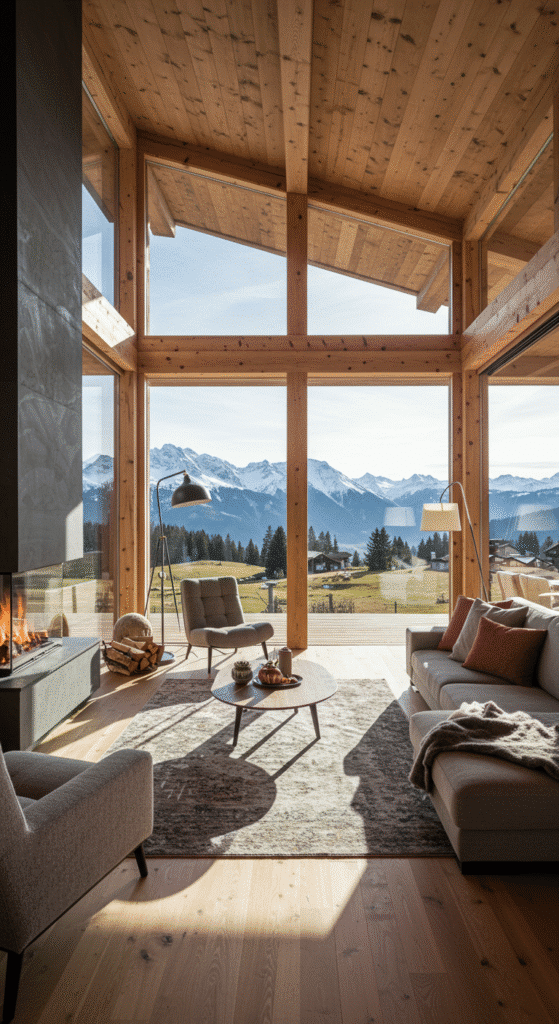
Furniture in alpine interiors is simple, sturdy, and timeless, often made from natural wood. Handcrafted pieces with visible grain and imperfections enhance authenticity. Large wooden dining tables become gathering spots for family and friends. Sofas and armchairs are upholstered in wool, linen, or leather for durability and comfort. Rustic benches, stools, and storage trunks add both function and character. By combining craftsmanship with practicality, alpine furniture feels grounded in tradition yet perfectly suited to modern living.
Fireplaces as Focal Points
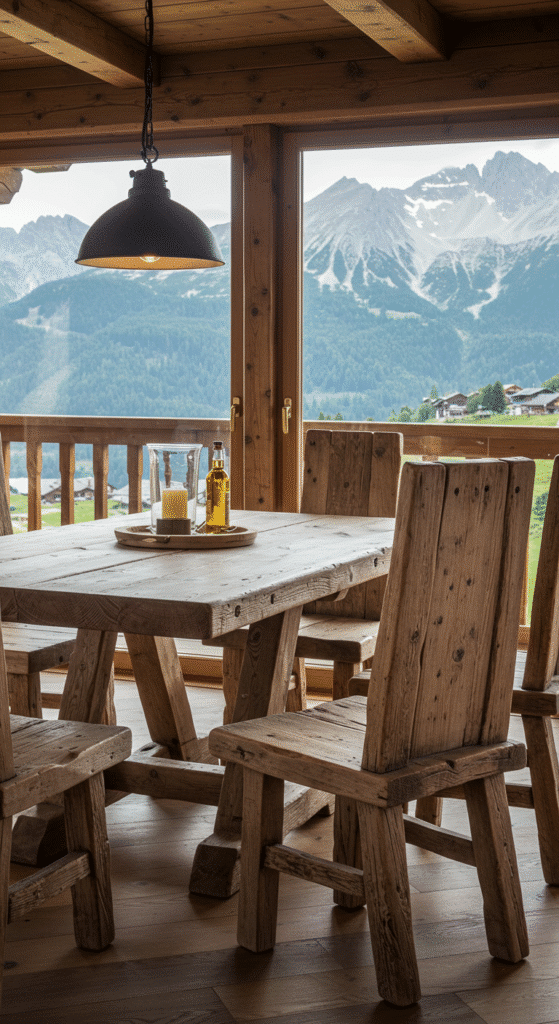
A fireplace is the heart of alpine interior design, symbolizing warmth and community. Large stone or brick fireplaces create dramatic focal points in living areas. Mantels decorated with candles, lanterns, or wooden accents enhance rustic beauty. In modern alpine homes, sleek fireplaces with natural finishes combine tradition with innovation. The crackling sound of fire adds to the sensory experience of coziness. Whether grand or minimal, fireplaces embody the soul of alpine living. They turn a house into a retreat that welcomes rest and togetherness.
Cozy Living Room Inspirations
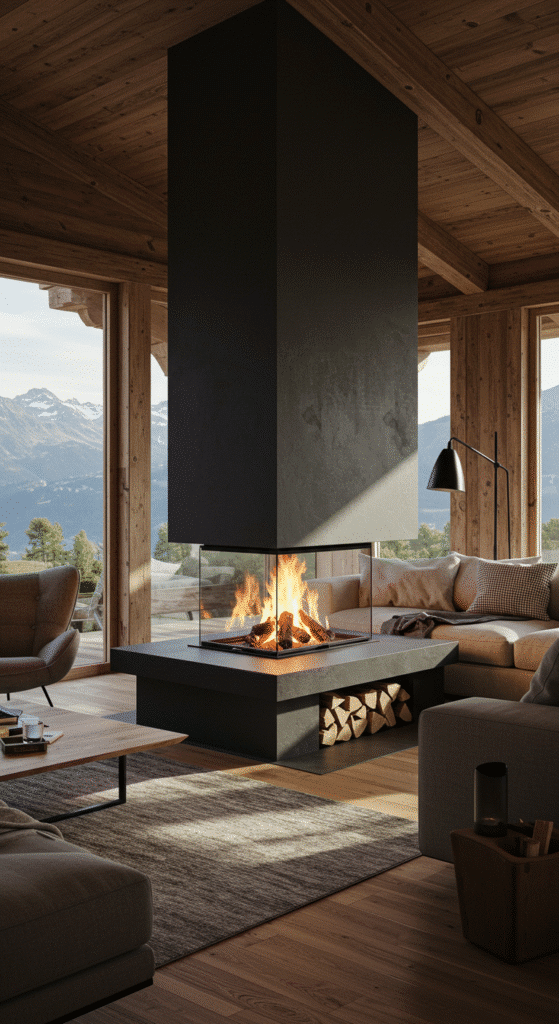
Living rooms in alpine design focus on comfort, making them ideal for relaxation and gatherings. Plush sofas and oversized chairs invite you to sink in and unwind. Layered throws and cushions add texture and warmth to seating areas. A large rug grounds the space while softening wooden floors. Natural light floods the room during the day, while warm lamps provide evening coziness. Every element is chosen to create an atmosphere where family and friends feel instantly at home.
Alpine Kitchen Design
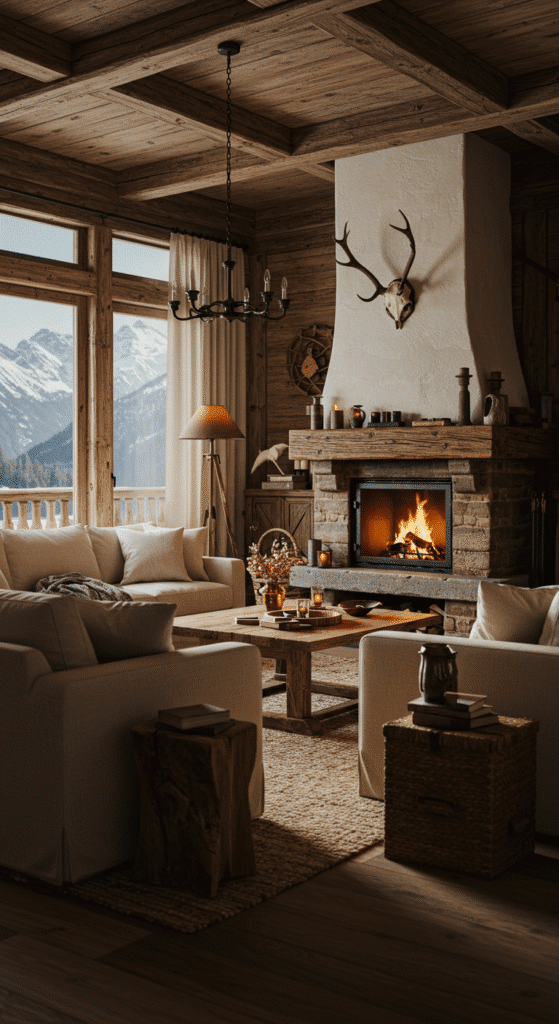
Kitchens in alpine interiors are warm, functional, and connected to natural materials. Wooden cabinetry paired with stone countertops creates rustic elegance. Open shelving displays pottery, copper pans, and handmade accessories. Large farmhouse-style tables often double as prep and dining spaces. Lighting is soft yet functional, with pendant lamps over key areas. By blending practicality with style, alpine kitchens become the heart of the home—where meals are cooked with care and shared with love.
Dining Spaces with Mountain Flair
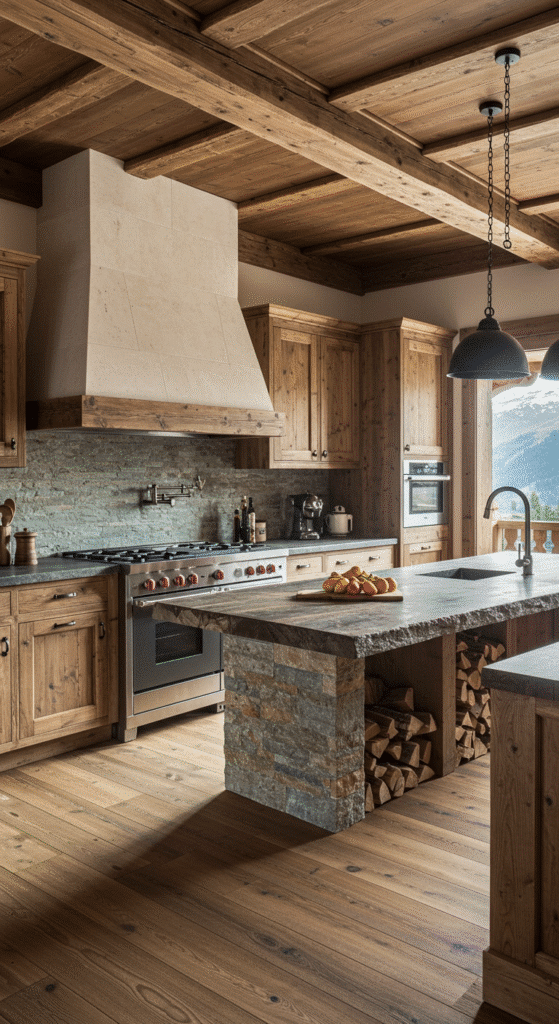
Dining areas in alpine interiors are designed for togetherness and warmth. Long wooden tables with sturdy benches or upholstered chairs create a welcoming setting. Natural textures like linen tablecloths and wool placemats enhance coziness. Candles and lanterns provide an intimate glow for evening meals. Large windows often frame scenic views, making dining a multisensory experience. The overall design balances rustic charm with functionality, creating spaces that encourage lingering conversations. Alpine dining areas are about more than eating—they’re about connection.
Alpine Bedrooms for Restful Retreats
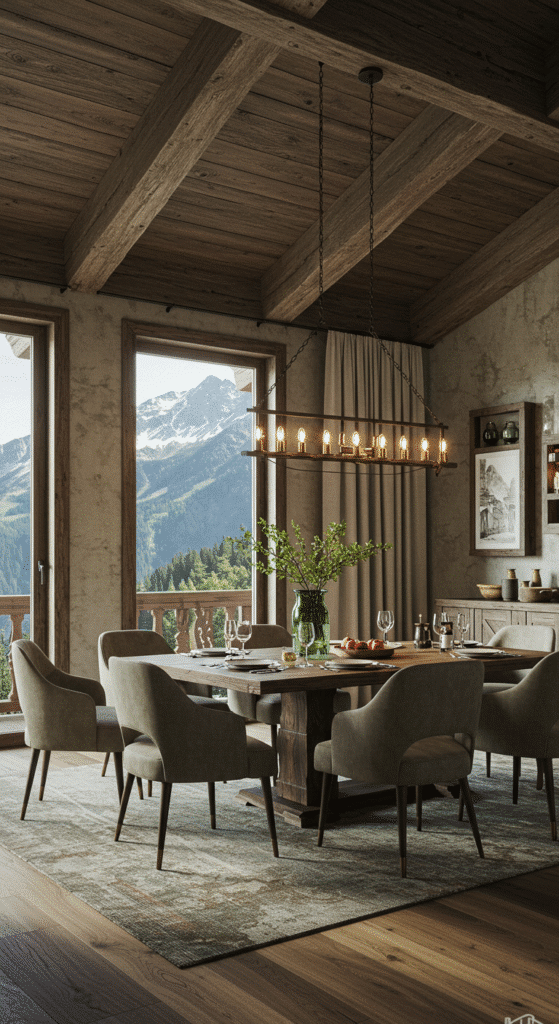
Bedrooms in alpine interiors are designed as sanctuaries of peace and relaxation. Wooden headboards, cozy quilts, and faux fur throws set a warm atmosphere. Neutral tones dominate, with earthy accents for grounding. Layered lighting—table lamps, sconces, and candles—creates a calming glow. Large windows frame views of the mountains or forests, enhancing tranquility. Every element is chosen to encourage rest and comfort, making alpine bedrooms feel like personal retreats. They embody the spirit of cozy mountain living.
Bathrooms Inspired by Nature
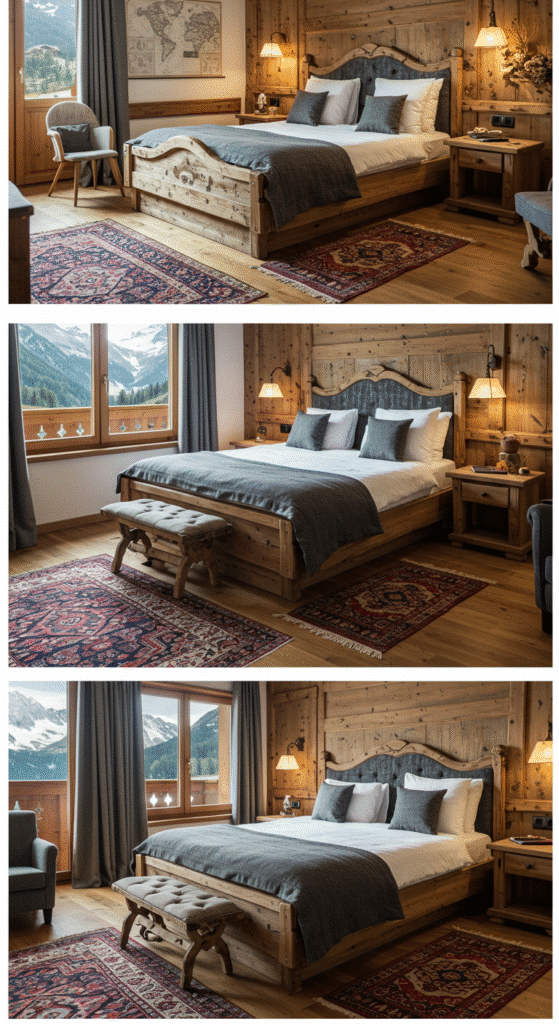
Alpine bathrooms bring the outdoors in with natural textures and calming tones. Stone tiles, wooden vanities, and warm lighting create a spa-like environment. Freestanding bathtubs placed near windows allow for scenic relaxation. Brass or black fixtures add rustic elegance while staying functional. Soft towels, candles, and greenery complete the serene atmosphere. These bathrooms combine rustic design with modern luxury, turning everyday routines into moments of calm. They prove that even utilitarian spaces can feel indulgent and inspired by nature.
Entryways with Warm Welcomes
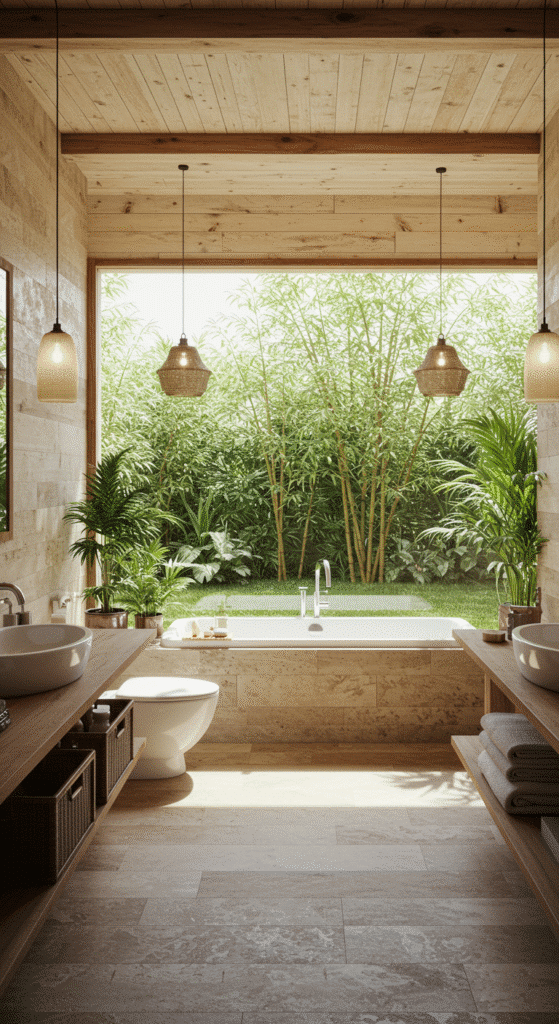
The entryway sets the tone for an alpine home, offering a warm embrace from the start. Wooden benches with storage make the space practical and inviting. Hooks and racks for coats, scarves, and boots reflect a mountain lifestyle. Rugs or runners add texture while protecting floors from outdoor elements. Natural light or lantern-style fixtures brighten the space. Small decorative touches like woven baskets or candles enhance coziness. Alpine entryways balance function with beauty, making guests feel instantly at home.
Alpine-Inspired Balconies and Patios
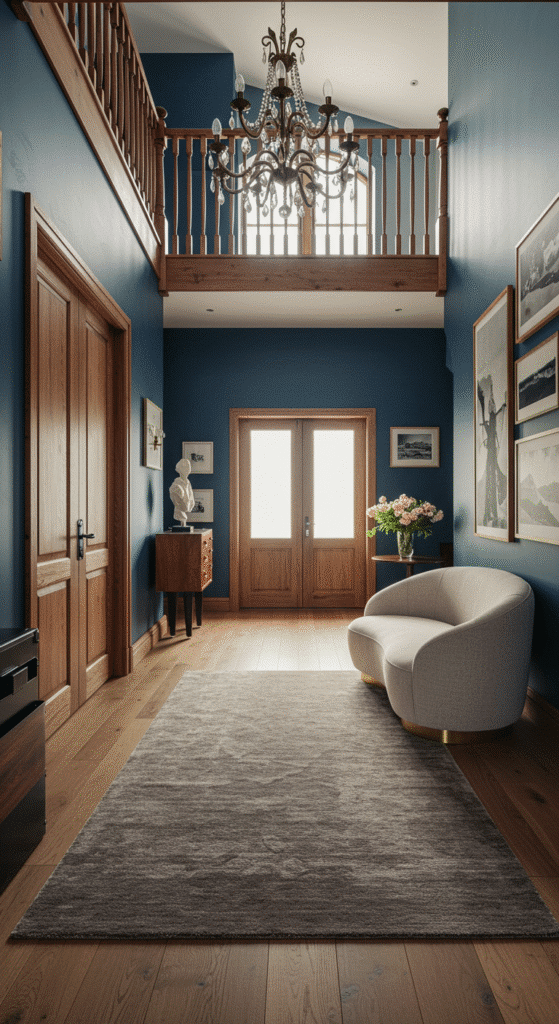
Outdoor spaces are extensions of alpine interiors, designed for comfort and natural connection. Wooden decks with cozy seating create perfect spots to enjoy mountain views. Wool blankets and lanterns make evenings outdoors inviting, even in cool weather. Natural stone flooring adds durability and rustic charm. Potted plants or small trees enhance the connection to the environment. Fire pits or chimineas extend usability throughout the seasons. These outdoor spaces are designed to encourage relaxation and appreciation of nature’s beauty.
Modern Touches in Alpine Homes
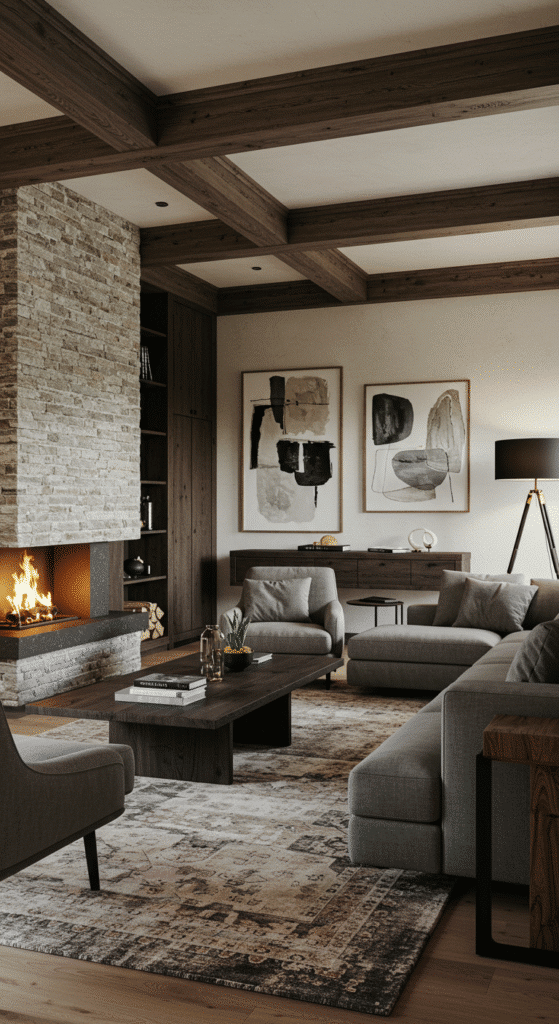
While rooted in tradition, alpine design can seamlessly integrate modern elements. Sleek furniture pieces with clean lines bring contemporary sophistication. Neutral color schemes paired with minimalist lighting update rustic foundations. Smart home technology can be subtly incorporated without disturbing the cozy atmosphere. Kitchens and bathrooms benefit from modern appliances paired with natural finishes. By blending old and new, alpine interiors remain timeless yet relevant. This adaptability ensures the style works in both traditional chalets and urban homes.
Minimalism Meets Alpine Style
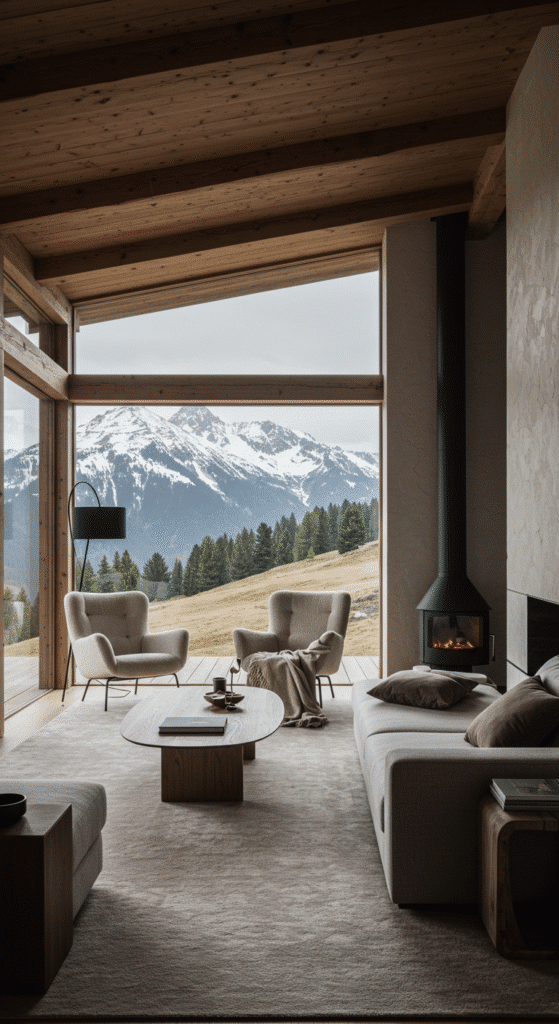
Minimalism complements alpine interiors by emphasizing simplicity and natural beauty. Clean lines and uncluttered spaces allow materials like wood and stone to shine. Furniture choices are purposeful, focusing on quality over quantity. Neutral color palettes maintain a calming, cohesive environment. Decor is minimal yet meaningful, often inspired by nature. This fusion of minimalism and alpine design creates serene, functional spaces that celebrate both coziness and clarity. It’s a balance of rustic warmth and modern restraint, perfect for contemporary living.
Sustainable Alpine Interior Design
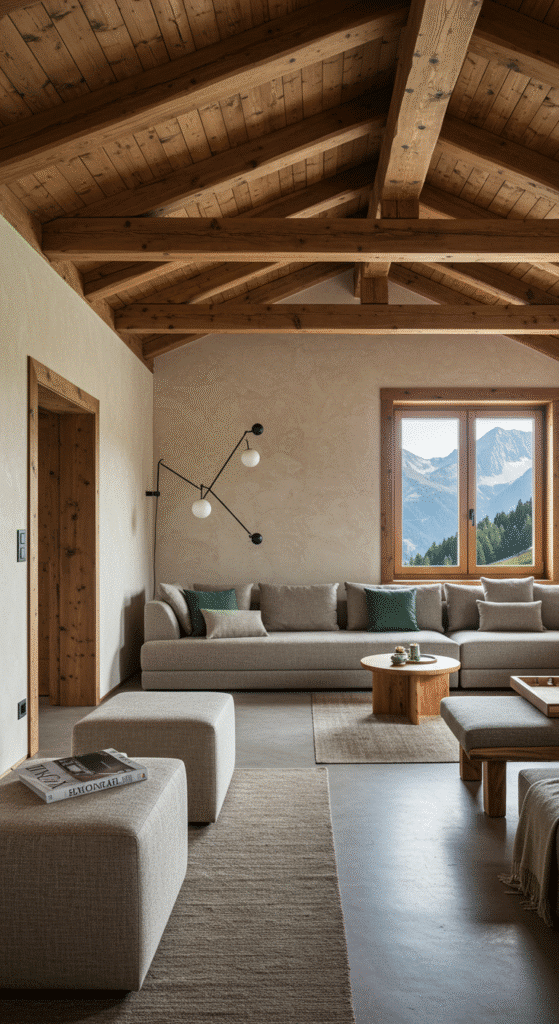
Sustainability is a natural part of alpine design, given its connection to nature. Using reclaimed wood and locally sourced stone reduces environmental impact. Energy-efficient lighting and insulation support eco-friendly living. Furniture crafted from durable materials ensures longevity, reducing waste. Natural fabrics like organic cotton and wool enhance comfort while staying eco-conscious. Alpine interiors prove that sustainable choices can be stylish and practical. By honoring tradition while embracing green practices, these homes create harmony between humans and nature.
Natural Light in Alpine Interiors
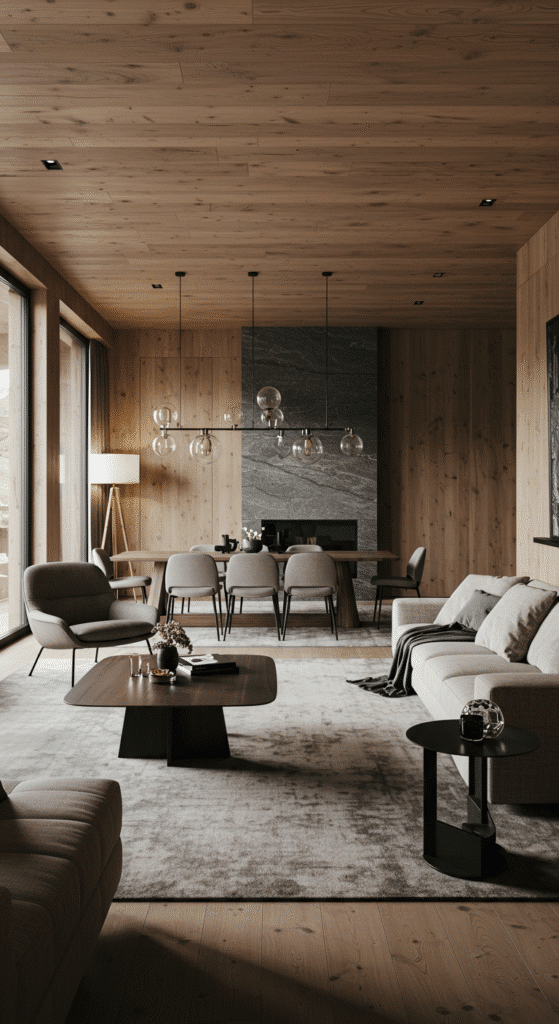
Natural light is a key element in alpine design, enhancing both comfort and mood. Large windows frame panoramic views, flooding spaces with daylight. Skylights and glass doors increase brightness while maintaining a cozy atmosphere. Sheer curtains allow light while preserving privacy. Reflective surfaces like mirrors and light-toned wood amplify brightness. This emphasis on natural light reduces reliance on artificial sources, creating energy-efficient spaces. Alpine interiors thrive on this balance of light and shadow, capturing the beauty of each season.
Seasonal Decor in Alpine Homes
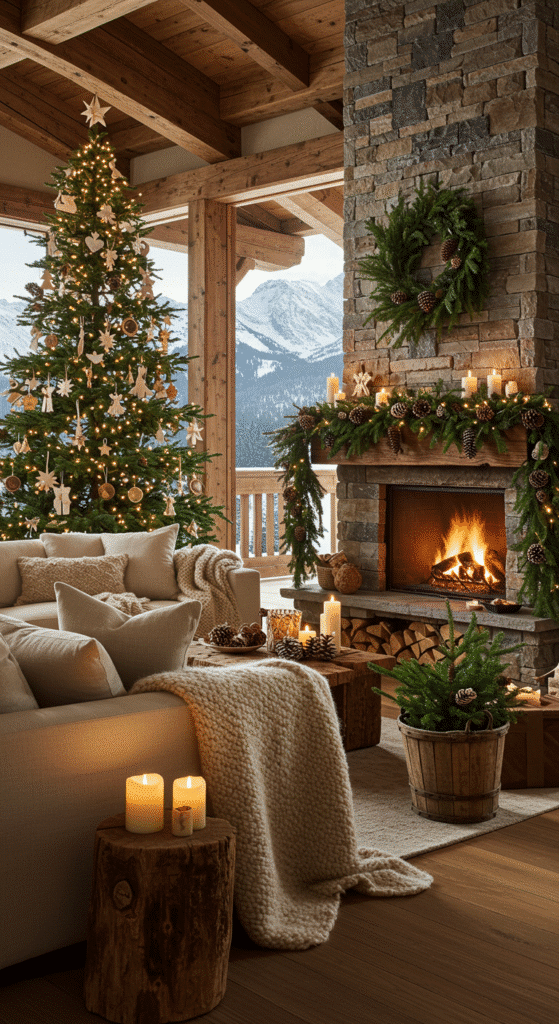
Seasonal decor keeps alpine interiors fresh and connected to nature’s rhythms. In winter, faux fur throws and heavy rugs add coziness. Spring brings lighter linens and floral arrangements to refresh spaces. Summer invites open windows, airy fabrics, and outdoor gatherings. Autumn inspires earthy tones, candles, and rustic accents. Rotating decor ensures the home adapts to seasonal moods without losing its alpine charm. These subtle changes keep interiors dynamic while maintaining their cozy foundation. Alpine homes embrace every season with style.
Layering Rugs for Warmth
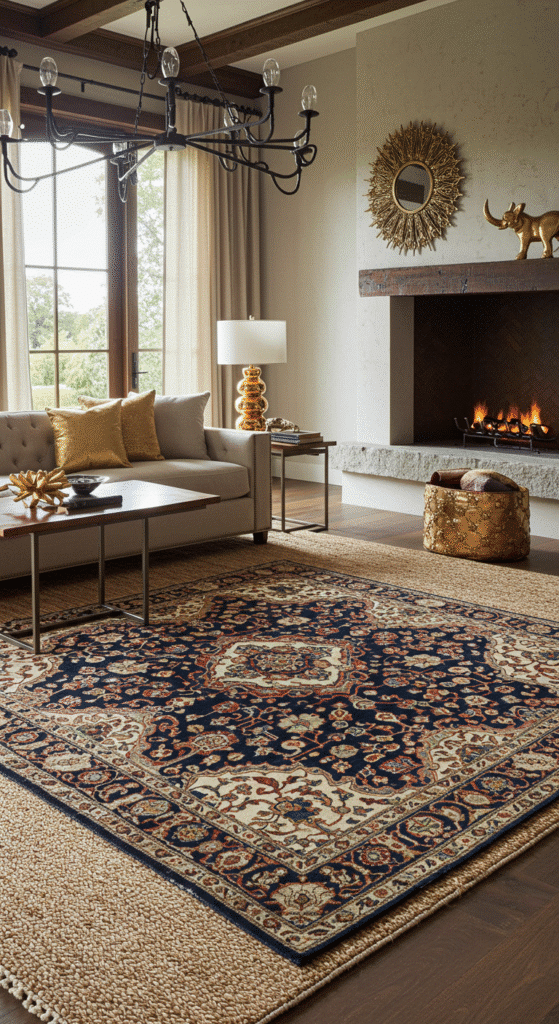
Rugs are essential in alpine interiors, providing warmth, softness, and visual interest. Layering rugs adds depth and coziness to wooden floors. Natural fibers like wool or jute complement rustic charm. Large area rugs anchor spaces, while smaller ones highlight specific areas. Patterns inspired by nature or traditional motifs enhance authenticity. Rugs not only serve practical purposes but also elevate aesthetics. In alpine homes, layered rugs create intimate, inviting environments perfect for cozy gatherings.
Wall Treatments in Alpine Interiors
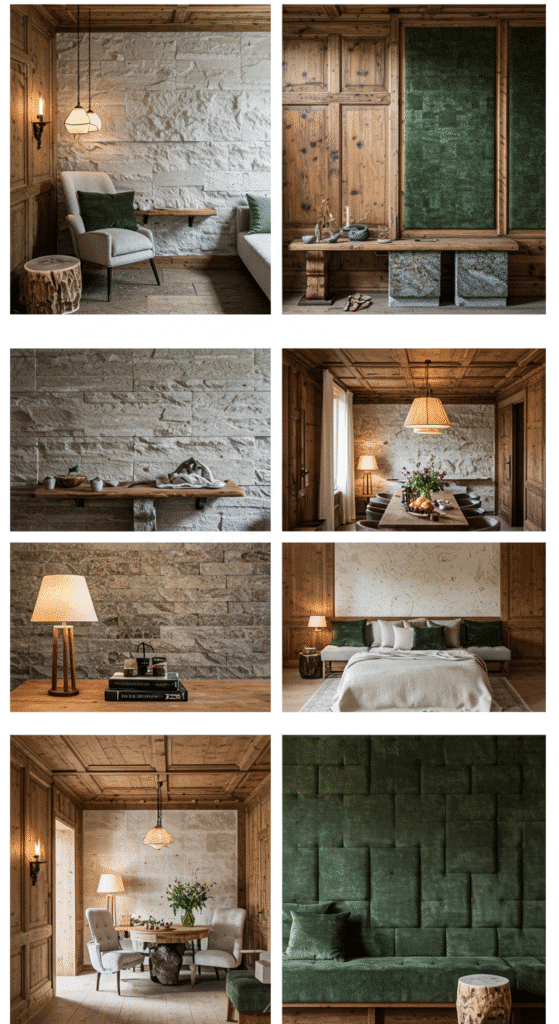
Walls in alpine interiors often showcase natural textures to reflect the environment. Wooden paneling or shiplap brings warmth and rustic appeal. Stone accent walls add drama and durability to living spaces. Neutral paint colors provide balance, ensuring rooms feel bright and open. Woven tapestries or textile art add softness and cultural flair. Wall treatments become canvases for natural beauty, grounding interiors in alpine authenticity. This thoughtful approach ensures walls contribute meaningfully to the overall aesthetic.
Alpine-Inspired Ceilings
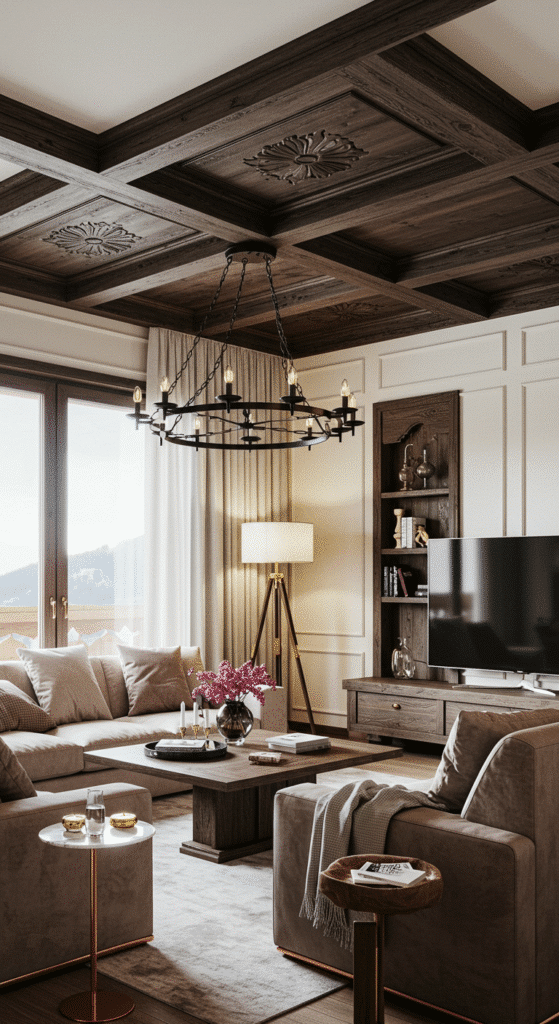
Ceilings in alpine interiors are often dramatic, highlighting architectural charm. Exposed wooden beams add rustic elegance and emphasize craftsmanship. Vaulted ceilings create openness, enhancing the flow of natural light. Wooden planks or tongue-and-groove treatments add warmth overhead. Skylights bring views of the sky and stars, enhancing connection to nature. These ceiling features draw the eye upward, making interiors feel spacious yet cozy. Alpine-inspired ceilings transform homes into mountain retreats full of character.

Hazel Collins is the creative voice behind Room Layered. With years of blogging experience, she shares her passion for home decor, DIY projects, and styling tips to help readers create beautiful, personalized spaces. Her ideas blend charm with practicality, making home inspiration feel both achievable and stylish.
